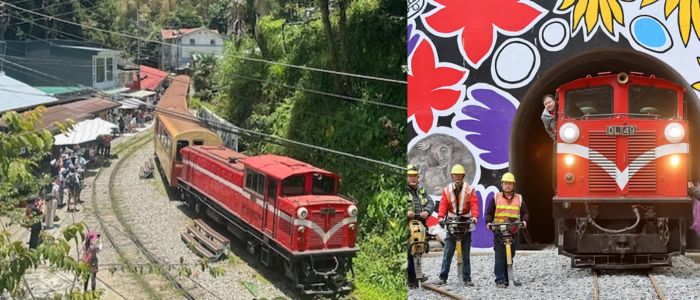Engineering And Culture, A Legacy
The Alishan Forest Railway was first built in 1900 under Japanese colonial rule at the request of engineer Iida Toyoji and designed to transport timber from high mountains down to Taiwan’s ports. The first train journey from Chiayi was completed in 1907, and the smoke machines used as the result of a financial strain could be entirely replaced by steam locomotives in 1912.
A standout characteristic is the Dulishan Spiral, which made a Guinness World Record (as the "world’s longest railway spiral") for a spiral stretching 5km in length and rising 233m in elevation, even though both ends are just 570m apart.
The damage over the years has not been inconsiderable: a fire in 1976 and the powerful Jiji earthquake of 1999 and then also completely under Typhoon Morakot in 2009. Col Scott wrote:"Despite these vicissitudes, the public never wavered in its support for recovery". As of 2013, alternate limited service has been restored with the assistance of the Taiwan Railway Administration and the Forestry Bureau.
A new site was designated in 2019, the Alishan Forestry and Railway Cultural Landscape, and in April 2024, the entire 71 km stretch between Chiayi and Alishan (2,216 m) station was reopened. On 29 April the first full passenger train returned.
The revitalization breathed life into stations such as Lumachan, known as a tobacco center — it now sits in the middle of rice fields and houses the Tobacco Cultural Park. And at Fenqihu Station, which was once teeming with coal workers and now a rather muted terminal, visitors have flocked — literally, it was kind of a throng — to see a refurbished steam engine and a cast-iron sign that read “Fen Chia” in Chinese calligraphy, a local food tradition brought back to life in the form of turkey rice bento boxes.
Linking Those of Like Mind
The railroad, however, doesn’t transport only tourists. The cable also serves as a crucial connection for the Indigenous Tsou communities, enabling them to get to schools, markets and medical care. The railway runs through bamboo forests maintained by these communities, and the area is filled with diverse wildlife, hosting over half of Taiwan’s species of firefly and large flying squirrels as well.
Another significant cultural event in 2022 was that the Alishan Forest Railway twinned in that year also with the Welshpool and Llanfair Light Railway in Wales. Bought over by Michael Reilly, former British Representative in Taiwan and current company secretary to the Welsh railway, a diesel engine which had once been in service in Taiwan now transports passengers through the hills of Powys.
Workforce representation and operation of the railway have also changed. Lo Yu-Ting, a former stationmaster at Taiwan’s highest station, Zhushan, is one of several women who are now taking on pivotal roles in running the railway. What she provides through her job, juggling operational roles with family life, and why it just goes to show how the railway supports its people through thick and thin.
From Past to Future
At Chiayi, the origin of the rail line, the old and new coexist. As high-speed trains zoom past, Alishan’s red diesel engines bumble their way up the mountain. A tourist attraction lined with preserved cypress houses and bubble tea shops, complete with bamboo crafts, it was at a time home to railway workers in Chiayi, and has been branded Hinoki Village.
The railway’s smiling mascot, a deer with a cap sporting the railway’s logo, is perched outside one of these wooden houses. Although rarely seen anymore, the deer in Taiwan still stands as a vivid symbol of longevity. Their presence — like the railway itself — is a reminder to visitors of the Alishan’s enduring strength and natural splendor, where a slow and scenic train ride is far more than just a trip.
Travel

Taiwan's Alishan Forest Railway Returns After Full Restoration

The Alishan Forest Railway in south-western Taiwan is finally chugging along again following years of disruption due to typhoons, earthquakes and economic woes. The rail was restored and reopened in 2024, its timber haul was established over a hundred years earlier. The train ride, which includes 50 tunnels, 77 bridges, and sweeping vistas of Alishan’s cedar forests, delivers more than just scenery — it is boosting local mountain villages, celebrating Indigenous culture and promoting slow, sustainable travel in Taiwan.















